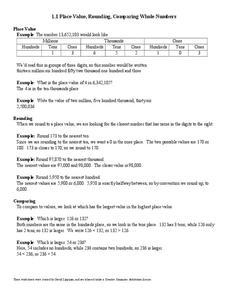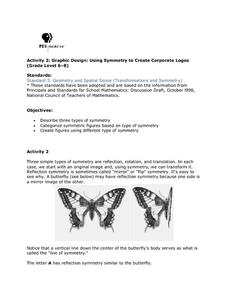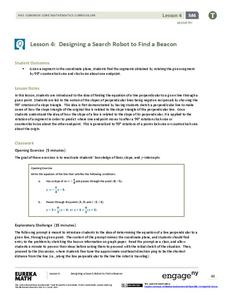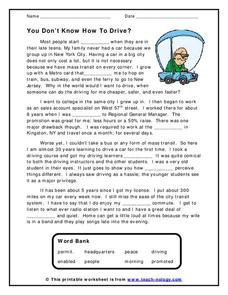Chymist
Esters: An Introduction to Organic Chemistry Reactions
Scratch and sniff an introduction to organic chemical reactions. A creative lesson has individuals study the esters commonly used in scratch-and-sniff stickers and advertisements. Following the lab procedure, scholars create the organic...
Curated OER
Subject Verb Agreement- To Have
Which option fits best: has, had, or have? Your English language learners read the 20 sentences provided and select the correct word to complete each sentence. Then, after selecting the correct words, they rewrite each sentence on the...
Illustrative Mathematics
Who Has the Best Job?
Making money is important to teenagers. It is up to your apprentices to determine how much two wage earners make with their after school jobs. Participants work with a table, an equation, and a graph and compare the two workers to see...
K12 Reader
Warm Up to Alliteration!
How can you tell if a sentence has alliteration? Use a short instructional activity to help kids identify examples of alliteration, complete sentences to create alliteration, and use nouns to write their own alliterative sentences.
Open Text Book Store
Arithmetic for College Students: Worksheets
Loaded with concepts ranging from multiplying decimals to converting units to solving problems using the order of operations, a thorough practice packet is perfect for a fifth or sixth grade math classroom.
PBS
Using Symmetry to Create Corporate Logos
Young mathematicians investigate the use of symmetry in graphic design. After first learning about reflection, translational, and rotational symmetry, children use this new knowledge to identify symmetry in letters of the...
Prestwick House
To Kill a Mockingbird
Harper Lee's classic tale of Scout Finch's experience with prejudice and racism, To Kill a Mockingbird, provides the text for a 23-clue crossword puzzle.
Curated OER
Auxiliary Verbs "Have or Has"
Interactive is the way to go! Type, click, and answer is what your class will do as they work through 4 different activities which provide practice using the auxiliary verbs have and has. Use this activity at an independent work station,...
Houghton Mifflin Harcourt
Sums to 100
Whether it's counting marbles, flowers, or playing cards, small objects can add up to great sums. Learners work six story problems to practice addition to 100. Some regrouping is required, along with distinguishing useful from irrelevant...
EngageNY
Describing Distributions Using the Mean and MAD
What city has the most consistent temperatures? Pupils use the mean and mean absolute deviation to describe various data sets including the average temperature in several cities. The 10th instructional activity in the 22-part series asks...
EngageNY
Using Tree Diagrams to Represent a Sample Space and to Calculate Probabilities
Cultivate the tree of knowledge using diagrams with two stages. Pupils create small tree diagrams to determine the sample space in compound probability problems. The lesson uses only two decision points to introduce tree diagrams.
Humanities Texas
Primary Source Worksheet: Excerpt from Reagan's Speech to the National Association of Evangelicals
Ronald Reagan's 1983 speech to the National Association of Evangelicals (also know as the "Evil Empire Speech") offers readers with an opportunity to practice their skills at reading informational text, specifically primary source...
Curated OER
Compare and Contrast Versions of a Story
Compare and contrast reading passages with the ever favorite story of Cinderella. The versions in focus include an Italian version and a Native American story followed by three questions designed to share similarities and...
EngageNY
Designing a Search Robot to Find a Beacon
Build right angles using coordinate geometry! Pupils explore the concept of slope related to perpendicular lines by examining 90-degree rotations of right triangles. Learners determine the slope of the hypotenuse becomes the opposite...
K12 Reader
The Spy Will Try Not to Cry
Learn all about the exploits of a sly spy from the short poem included on this resource. The poem, intended to provide practice with long /i/ words that use the letter y, is paired with three reading comprehension questions for pupils to...
Curated OER
Use Addition to Subtract
Young scholars practice solving word problems. They subtract one-digit problems, add to check their answers, and attempt to determine which problems have too much information. There are 6 problems to solve.
Read Works
How to Say “I Ruff You”
Who says you need a human to be your valentine on Valentine's Day? Give your dog-loving readers an inspiring perspective on how a sister givdes her brother a valentine from the family dog. They then answer 10 questions thatd involve...
K12 Reader
Making Connections to Text
This short reading comprehension learning exercise encourages readers to make self-to text, text-to-text, and text-to-world connections as a way of remembering what they have read.
Curated OER
To Kill A Mockingbird: Study Guide Part I
Readers of To Kill a Mockingbird summarize events, identify characters, and analyze actions in the first 11 chapters of Harper Lee’s novel. The carefully crafted questions could be used to guide reading or as the basis of group or...
MathMovesU
Practice: Measuring Angles and Using a Protractor and More!
Four fabulous worksheets are included in this resource, all having to do with the measurement of angles. On the first, anglers will use a protractor to determine the degrees of 10 different angles. An arc is drawn on each. On the second,...
Teach-nology
You Don’t Know How to Drive?
A cloze reading passage about getting a driver's permit at an older age prompts kids to use context clues as they read. They can use the word bank below to fill in eight blank spaces throughout the story.
Curriculum Corner
Going On A People Hunt!
Send the new faces in your class on a people hunt with a quick back-to-school, get-to-know one another activity. Learners are tasked to find a person in their class with blue eyes, wears glasses, has a birthday in March, and...
Curated OER
Using Por and Para
Clear up confusion around por and para. These words can be very difficult, especially for learners who are native English speakers. The information section describes when to use each word and provides examples of specific situations....
Minnesota Literacy Council
Scientific Method
Here is a resource with a descriptive approach to explaining the scientific method. It's simple, but effective for both introduction and reinforcement of this concept.























